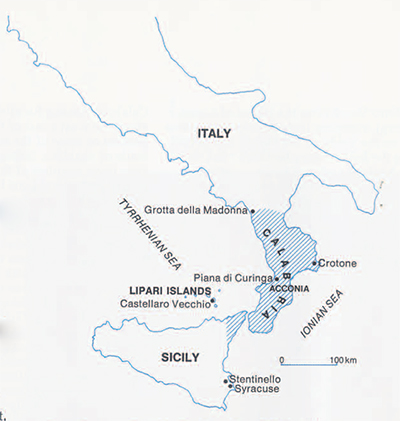
Pottery is a standard item for archaeological analysis—it was made by most later prehistoric and historic societies, it displays a wide range of variation in manufacture, form and decoration, and it survives well. However, the interpretation of pottery on residential sites is often difficult, since it occurs only as scatters of sherds, the end-product of use, breakage, and discard. Thus, the discovery of a group of almost complete pots, apparently in a primary household context, offers unusual opportunities to the archaeologist.
This article details the first stages of analysis of a group of five decorated pots from the early Italian Neolithic site of Piana di Curinga, where the collapse of a burnt wattle-and-daub house is responsible for their remarkable preservation. Like most Stentinello pottery, these pots have a wealth of variation in decorative designs. Unlike most Stentinello pottery, however, they are almost complete, so that we may see what decorative methods and motifs occur together on the same pot—a task often impossible when dealing only with residual sherds. By examining in detail how the stamped and incised decorations on a vessel are made, we can begin to perceive a certain order underlying the apparent wealth of variation. At the same time, one of the factors contributing to diversity among the decorative designs seen at the household level (as opposed to the settlement as a whole) may be the exchange of vessels between households and, as in the case of obsidian from the island of Lipari, perhaps even between settlements in different parts of Calabria.
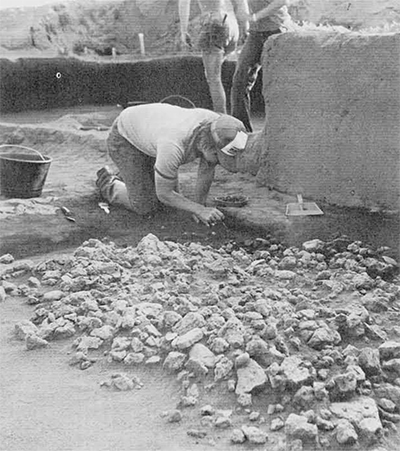
Decoration obtained by impressing the surface of a vessel with the edge of a shell or some other tool is the hallmark of the earliest pottery in the western Mediterranean. The term impresso is often used for this reason to refer to the early Neolithic cultures in the area extending from Italy to Spain. Within the western Mediterranean, several regional traditions of impressed-ware Neolithic pottery can be distinguished on stylistic grounds. The one that stands out from the others in the degree of elaboration of its decorative motifs is the Stentinello tradition of southern Italy and Sicily. Specially prepared stamps are commonly employed for making; impressions and as many as five different stamps or tools may be used on a single vessel to produce a complex decorative design. Recent excavations at the site of Piana di Curinga in Calabria have brought to light the first good series of houses dating to the Stentinello period. Found in association with one of the wattle-anddaub houses (in Area H) were five more or less whole fine-ware bowls. As a group, these vessels afford a rare opportunity for studying the refinement and richness of on of the earliest ceramic traditions in Europe.
The name Stentinello comes from the settlement, near Syracuse in Sicily, that Paolo Orsi excavated at the end of the last century. With the exception of the work done by Bernabò Brea at the site of Castellaro Vecchio on the island of Lipari (see map), comparatively little progress was made on the study of the Stentinello period during the half century between 1925 and 1975. A whole series of basic questions remained unanswered, including the dating of the culture in absolute terms by means of radiocarbon and the extent of local variation in styles of ceramic decoration within the tradition. Only a few fairly complete vessels were known for the period and these came almost entirely from sites near Syracuse in southeastern Sicily. Indeed, in 1960, the distribution of Stentinello sites was still thought to be confined to Sicily and Malta. Even as late as 1970, there was little evidence for Stentinello occupation in Calabria, the region of peninsular Italy adjacent to Sicily. Some material had been found near the town of Gerace and a few Stentinello sherds, considered to be imports, had been recovered at the Grotta della Madonna in northern Calabria. It was widely held that during early Neolithic times two distinct cultural spheres—one corresponding to peninsular Italy and the other to Sicily and nearby islands—could be recognized in the central Mediterranean. Since few sites were known in Calabria at the time, there was the notion that the rugged landscape of this region seemed to offer few attractions for Neolithic settlement. However, survey work conducted during the last ten years has led to the identification of an extensive series of prehistoric sites in Calabria, including more than twenty Stentinello sites. Thus, the geographic distribution of the culture has been substantially enlarged, and the simple dichotomy between mainland Italy and the islands has at the same time broken down.
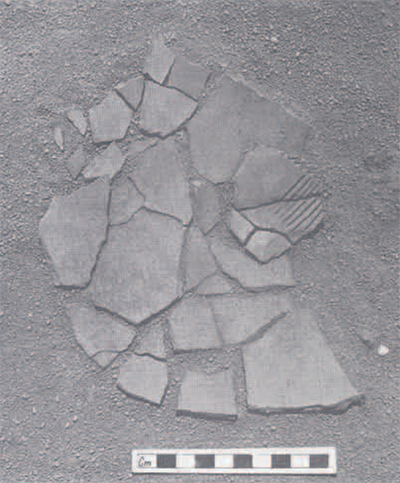
Recent studies of obsidian exchange networks suggest that Calabria holds a key position in the interactions between the two main cultural spheres in southern Italy. Obsidian, a volcanic glass used for making tools, occurs on the island of Lipari (see map), and this was the main source of this material for prehistoric sites in Calabria. Since the start of survey work in 1974, more than two hundred sites yielding obsidian blades and flakes that date from the Neolithic period through the Bronze Age have been located in various parts of Calabria. Among Stentinello sites situated along the west coast of the region, ninety percent or more of the stone tools are made of obsidian, indicating a heavy reliance upon supplies of the material from Lipari. Note that Lipari lies some fifty miles off the Calabrian coast.
Survey and Site Identification
As part of the Calabria Survey, several areas within the region were singled out for intensive coverage with the aim of discovering how dense patterns of Neolithic occupation could be. In the case of the Acconia area, located on the Gulf of Sant’ Euphemia, repeated coverage of some six square miles of the landscape over a five year period made it possible to build up a comprehensive pattern of Neolithic settlement. It is worth commenting from a methodological point of view that only part of the overall site distribution could be recognized during any one season of field work. Quite different settlement patterns would have been obtained for the Acconia area if the conventional approach to surveys in the Mediterranean, based upon a single season of coverage only, had been employed. Six main Stentinello settlements which date for the most part to the 5th millennium B.C., as indicated by a recent series of (uncorrected) C-14 dates, were identified at Acconia in this way. The settlements all occur in association with dune areas: the preferred location for a Stentinello site would appear to be near the edge of a dune and in proximity to a small stream. Four of the settlements, including the one known as Piana di Curinga, are reasonably large in size and cover an area of four acres or more.
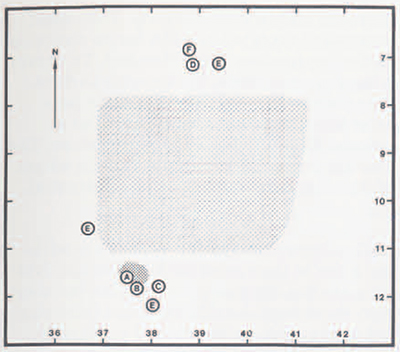
It is common for decorated pottery, obsidian tools, and fragments of daub representing the remains of collapsed wattle-and-daub buildings to be seen on the land surface at various points within a Stentinello settlement. The remains that are observed on the surface, and that in effect make the recognition of prehistoric sites possible, appear to derive in many cases from recent disturbances of the landscape caused by the introduction of modern practices of land use. An inflating landscape is, in fact, responsible for the excellent preservation of many prehistoric sites near Acconia. Since Stentinello times, the dune areas have experienced a long term inflation that is usually on the order of one to two meters. Such buried sites offer an unusual opportunity for the excavation of well preserved Neolithic houses. Our knowledge of Neolithic buildings in the western Mediterranean is still remarkably limited. The real question, of course, is how to locate houses buried in such an inflating landscape.
In our case, a magnetometer survey conducted by Alister Bartlett and Andrew David of the Ancient Monuments Laboratory in London helped to solve the problem. A reasonable quantity of daub which has been fired is found in association with Stentinello houses known in the Acconia area and, as a consequence of the induced magnetism produced when the daub is baked, the buildings generate magnetic anomalies. Once an anomaly was detected during the magnetometer survey, borings could be made to confirm the presence of a wattle-and-daub structure and to define its actual position in the ground. Borings can be done quite easily in the dunes and there is a good contrast in terms of both color and texture between the dune soils and the daub remains. By means of this strategy, it was possible to locate more than forty-eight Stentinello structures at the site of Piana di Curinga.
The third step in the field work was the actual excavation of several of the buried houses.
Piana Di Curinga
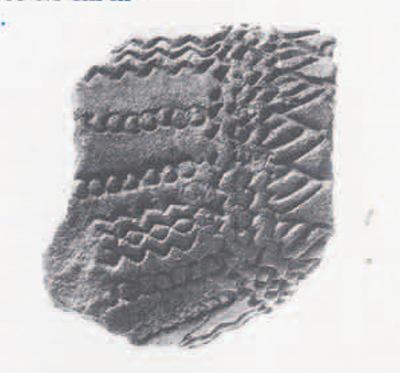
No doubt the best preserved and most interesting house to be excavated to date is the one from Area H at Piana di Curinga. This is the structure that produced the Stentinello vessels that we shall turn to shortly. The excavation of the structure was carried out under the supervision of Sandro Bonardi of the University of Parma and Gary Shaffer at S.U.N.Y., Binghamton. All pieces of decorated pottery and obsidian as well as fragments of daub measuring 10 centimeters or more in length were individually recorded and collected in the field. In all, more than a ton of sintered daub fragments were recovered from the collapsed wattle-and-daub structure in Area H. Detailed studies of the building remains by Gary Shaffer form the basis for the reconstruction of this structure, which is essentially rectangular in plan and measures about 4.5 meters in length and 3.3 meters in width. Support for the walls was provided by a framework of saplings, daubed with clayey sediments obtained from alluvial terraces occurring at the edge of the dune. The floor of the house was simply the levelled surface of the dune itself. The interior appears to have been kept quite clean, few finds were actually recovered inside the house.
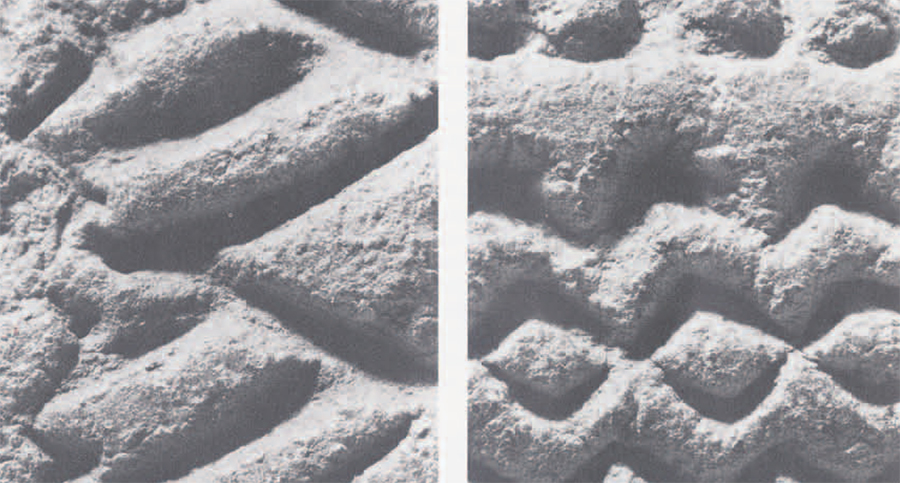 Most of the pottery was found just outside the north and south walls of the building. Trapped below the collapse of the south wall were three decorated fine-ware vessels (A-C) found in association with a small stone feature. Two other pots were found near each other on the north side of the building: vessel D, a decorated fine-ware bowl, and vessel F, a small undecorated coarse-ware bowl. Three separate groups of sherds belonging to vessel E, a decorated fine-ware bowl, were recovered on different sides of the structure. In the latter case, it is far from clear how this spatial distribution should be interpreted. Without going into an account of the distributions of other ceramic and lithic finds here, mention should be made of the fact that almost all of the decorated coarse-ware pottery occurs on the north side of the house. The one radiocarbon sample dated so far co. 5740 B.C. would make this structure one of the earliest known for the Stentinello period in Acconia.
Most of the pottery was found just outside the north and south walls of the building. Trapped below the collapse of the south wall were three decorated fine-ware vessels (A-C) found in association with a small stone feature. Two other pots were found near each other on the north side of the building: vessel D, a decorated fine-ware bowl, and vessel F, a small undecorated coarse-ware bowl. Three separate groups of sherds belonging to vessel E, a decorated fine-ware bowl, were recovered on different sides of the structure. In the latter case, it is far from clear how this spatial distribution should be interpreted. Without going into an account of the distributions of other ceramic and lithic finds here, mention should be made of the fact that almost all of the decorated coarse-ware pottery occurs on the north side of the house. The one radiocarbon sample dated so far co. 5740 B.C. would make this structure one of the earliest known for the Stentinello period in Acconia.
Once the excavations in Area H were finished, the next task was the patient one of trying to join the sherds belonging to the various pots. Since the position of each decorated sherd had been recorded during the excavations, joins between sherds would provide information on the mechanics of breakage and deposition as well as permit the reconstruction of the vessels. For example, it can be seen for vessels A through D that the two most distant sherds belonging to a given pot occur in each case less than 1.8 meters apart. The implication here would be that the vessels were essentially broken in situ, rather than broken elsewhere and the sherds thrown away. As the work on the joining of sherds progressed, it became clear that a series of distinct vessels could be recognized in Area H.
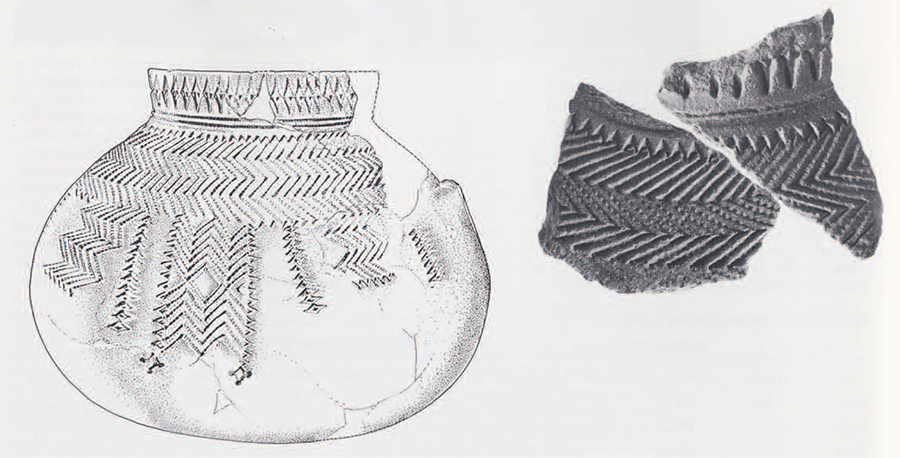

Since the ceramic material recovered at prehistoric sites is often highly fragmentary, it is often the practice for the study of pottery to be conducted in terms of the classification of individual sherds. Rather than following this approach, there was the chance in the present case of basing the study upon individual vessels. The advantages of such a vessel oriented approach can be seen when it comes to bath stylistic analysis and behavioral interpretations of the material. An estimate can be made of the minimum number of vessels represented among the decorated fine-ware sherds recovered from Area H, as indicated in Table 1. Of a total of 210 sherds, we see that fully two-thirds come from the five ‘whole’ vessels mentioned above. There are eight vessels that each have two or more ‘joining’ sherds and that together account for 42 sherds. Among the remaining sherds, a further eight vessels can be distinguished on the basis of differences observed among ‘single’ rim sherds, bringing the total number of fine-ware vessels to at least twenty-one. While a few more vessels may be represented among the ‘single’ body sherds, most of the sherds here probably belong to those vessels already counted under the ‘joining’ and ‘single’ headings. It is worth adding that fine-ware pots without decoration are seldom encountered at Stentinello sites near Acconia and examples of such vessels do not appear to be present in Area H. Thus, the number of fine-ware vessels occurring in the immediate vicinity of the structure would be at least twenty-one and perhaps no more than twenty-five.
An estimate of the minimum number of coarse-ware vessels can be made in much the same way. The vessels that belong to this class are generally larger in size, have thicker walls, and are of coarser fabrics. Their decorations, which often involve the use of the potter’s fingers or the edge of a simple tool, are also less refined. There are at least seven different vessels represented among the decorated coarse ware sherds. It is worth recalling that vessel F on the north side of the structure is a coarse-ware vessel which has not been decorated. In addition to this whole pot, several other undecorated coarse-ware vessels are likely to be associated with the structure. This means that there are at least eight and perhaps as many as twelve coarse-ware pots in all. If a comparison is made only in terms of decorated vessels, there would be three of those in a fine ware for each one in a coarser ware.
When it comes to interpreting the ceramic remains as a whole, two quite different situations can be recognized with respect to individual vessels. On the one hand, a few pots are each represented by a large number of sherds. On the other hand, most of the vessels are represented by only a few sherds. In other words, only a small part of the original vessel is represented.
One interpretation here would be that the former are vessels that were in use or in actual circulation at the time of the collapse of the wattle-and-daub structure, while the latter would constitute pots in prior circulation that had broken near the structure and some of whose sherds had managed to escape being swept up in housekeeping. If this explanation is correct, it would mean that somewhere between thirty and forty of the vessels in circulation at one time or another during the occupation of the house actually happened to break near the structure. This may begin to give us some idea of the number of vessels that were in use during the occupation of a Stentinello house.
The Pottery: Production
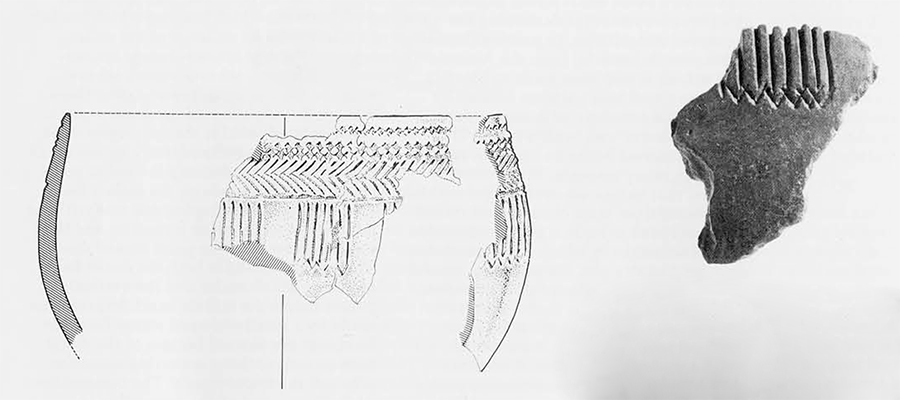
It is worth describing briefly how the fine-ware vessels were made. The following description draws upon observations on ceramic technology made by Sandor van der Leeuw of the University of Amsterdam. The fine-ware pots are actually quite limited in the range of their shapes and sizes. They usually occur as bowls that are slightly closed at the mouth and that have rounded rather than flat bases. Most vessels have a diameter that falls in the range of between 16 and 22 centimeters. The pottery is on the whole of extremely good quality, a careful selection of clay being reflected by their fine pastes. A turntable support was used in the actual construction of a pot, with the walls being built from coils. There are traces on some pots which indicate that wraps may have been employed during its construction as a means of supporting a vessel’s walls. Scraping marks are often observed on the interior surface of a vessel. The characteristic thinning of the interior of the rim was obtained by means of smoothing between the potter’s hands. The decoration, based upon impressions and incised lines (which will be examined in greater detail below), was applied while the clay was still in a plastic state. The vessel was usually rotated in a clockwise direction as the impressions were stamped. To obtain a fine lustrous finish, the exterior surface was polished extensively. On some pots, after firing, red ocher was pressed as a colored filler into bands of impressions. The amount of work spent in the various stages of finishing a vessel was often substantial.
Pottery Decoration
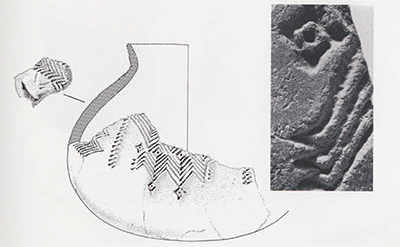
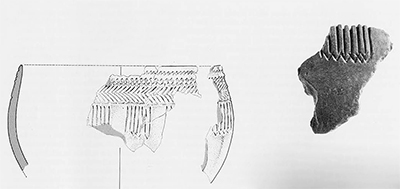
The decorations of the vessels are without a doubt their most striking feature. Not only are the designs quite complex but they also show considerable variation from one pot to the next. As mentioned previously, specially prepared stamps were used in applying the impressions: up to five different stamps and tools can be used in executing the decoration of a single vessel. As known from Stentinello sites in Sicily and Calabria, the stamps themselves are often small objects that have been molded in clay and then fired. The impressions are stamped individually, with the exception of those multiple impressions made by a comb or dentated spatula. It is common for the impressions to be organized in terms of a series of horizontal bands. Three main bands are regularly observed on the vessels in Area H: (1) a thin band near the rim, (2) a middle band containing a ‘dense field’ of impressions, and (3) a lower band presenting groups of vertical or diagonal lines.
We spent some effort trying to develop an adequate system for describing the impressed decorations. In previous studies of Stentinello material from the Acconia area, attempts had been made to identify decorative motifs or patterns formed by groups of impressions with names such as ‘fisherman’s net’ and ‘wolf’s teeth.’ This approach turned out to be far from satisfactory in many respects. We eventually realized that before we could begin to think about motifs, we must observe and record the stamp used to make a given impression and the sequence in which the impressions were applied to a pat. For example, careful observation of the sides of an impression and the deformation in them that results when an adjacent impression is subsequently stamped permits the order of stamping to be determined. A notation system was developed that made it possible to record in effect how a decorative design was executed. In making a comparative study of decorative designs on different pots, one question of obvious interest is whether or not a ‘grammar’ of execution can be discovered.
The Individual Vessels
The pot with the most elaborate decoration is vessel A, which happens to be the Only collared vessel found in association with the structure. This vessel form is uncommon at Stentinello sites in the Acconia area. The collar was apparently applied with the aid of string which has left two rings around the base of the collar. Altogether five different stamps are employed in decorating the vessel, whose exterior has a reddish brown color: three v-shaped stamps in various sizes, a comb, and a pointed tool for the dot impressions. Although it is not immediately apparent, an elongated v-shaped stamp is used to make the band of diamonds on the collar: this is achieved by first stamping one row with the point of the impression turned up and then a second row with the point turned down. The comb is used for both the dense field on the upper shoulder and the vertical panels below the middle band. Impressions made by a small v-shaped stamp form the border at the top and bottom of the dense field as well as those occurring along the edges of the lower panels. The composition of the lower part of the decoration is remarkably varied: vertical panels, which each differ from one another, alternate with vertical rows of diamonds that are made as in the rim band from a v-shaped stamp. As can be seen in the illustrations, two of the lower panels located on opposite sides of the vessel are much more elaborate than the others. They both have in addition, a pair of diamonds (again obtained from a v-shaped stamp) placed at the bottom of the composition.
Vessel B is more typical of the fine-ware pots at Piana di Curinga in both its form and decoration. The highly fragmented con. dition in which the pot was found would seem to be due to a combination of poor firing and insufficient temper in the paste. The band of decoration just below the rim is made with a diamond-shaped stamp that has a hollow center. A smaller diamond-shaped stamp with a solid center is used to produce the two rows forming the upper part of the middle band, while the dense field itself is formed from diagonal lines impressed with a smooth spatula. The lower band consists of groups of vertically incised lines that are finished at the bottom with a v-shaped border stamp. This brings to four the total number of stamps and tools that are used in the decoration of the vessel.
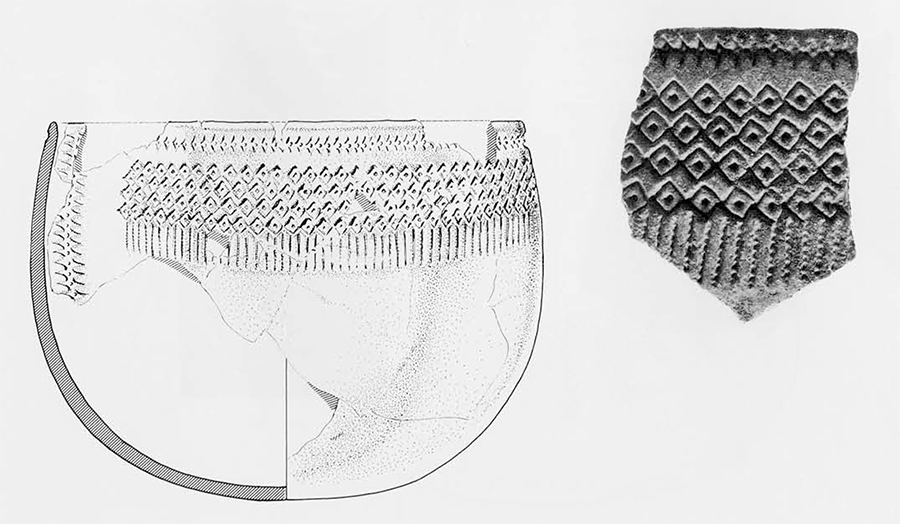
In the case of vessel C, whose exterior has predominantly a reddish brown color, the decoration is executed with three different stamps. The rim band is produced by a diamond-shaped stamp with the single row of impressions being made point-to-point. A stamp with a raised central dot is used for the dense field which consists of four staggered rows of diamond impressions. The lower band is made from a series of vertical comb impressions. The three bands in this case do not run completely around the pot but are interrupted on one side of the vessel. The ‘zipper’ decoration occurring at the band break is obtained by using the comb (stamped horizontally here) in combination with the stamp used for making the diamond impressions in the rim band.
The exterior surface of Vessel D has a fine lustrous finish and is dark red in color. Again, three different tools are employed in producing the decoration. Three rows of impressions made with a v-shaped stamp appear in the top band: this represents an unusual choice of motif for the rim band at Piana di Curinga. The same band of impressions is repeated in the middle of the design. Between these two bands there is a separate row of impressions made with a diamond-shaped stamp. Traces of red ocher can be observed at various points in the impressions forming this band. The lowest band consists of groups of parallel lines with three strokes being made to impress each of the vertical lines.
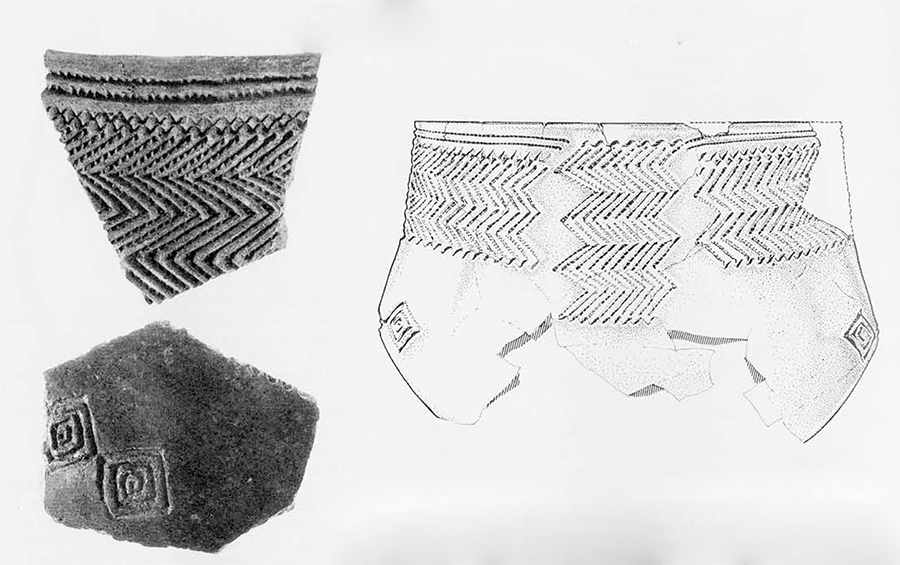
Vessel E has a decorative design which is more like that of vessel A than the other three pots. A distinctive feature here is the occurrence of so-called eye motifs on opposite sides of the vessel. The exterior is black and the vessel walls are at some points remarkably thin, suggesting extensive polishing. Traces of red ocher are observed at places in the rim band, which consists of two horizontal rows of comb impressions. A different comb is used to obtain the dense field, while a v-shaped stamp gives rise to the row of open
diamonds just above it as well as the border along the bottom of this band. The same comb is used for a separate vertical band which contains in all seven rows of impressions. The border at the bottom here is produced by the same stamp that was used for the border of the dense field, while a larger v-shaped stamp is used for the border at the top. The pairs of nested diamonds occurring lower on the wall were not impressed but rather engraved in the surface when the pot was somewhat drier. Pairs of such concentric circles and nested diamonds are regularly seen at Stentinello sites in Sicily and Calabria: they have conventionally been interpreted as eye motifs. Support for this interpretation is provided by the occurrence in some cases of eyelashes and other facial features in association with the eyes. If we look back at vessel A, we see that eye motifs may be echoed in the pairs of diamonds which appear at the base of the two main lower panels.
Discussion
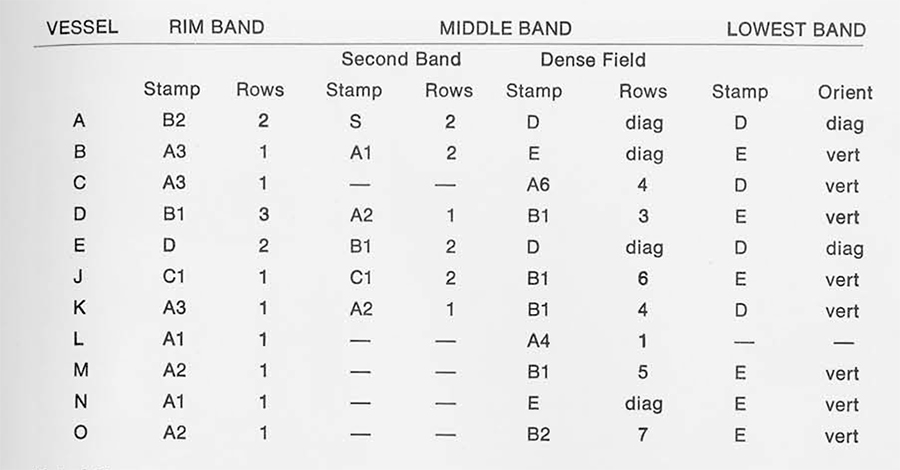
Stamps used in executing the main bands of decoration on eleven fine-ware vessels from Area H. Border stamps such as dots are not indicated in the table.
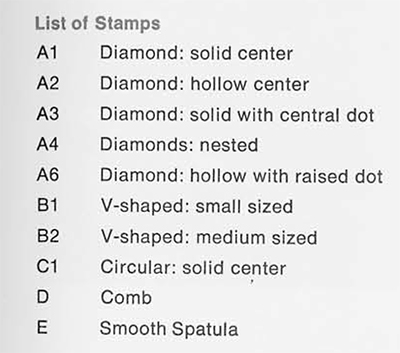 for a series of vertical lines which can be either impressed with a comb or incised. There are three vessels where this basic pattern is not followed. Vessels A and E present diagonal lines rather than vertical ones—it is worth adding that the comb used for making these lines is in each case the same one that is employed for producing the dense field. A more pronounced departure is observed in the case of vessel L which has no third band. The part of the design showing the greatest degree of variation is the middle band. Only half of the vessels in Table 2 have the so-called second band which occurs (when present) between the rim band and the dense field. Among the various stamps and tools used to execute the dense field itself, one of the more common ones is a v-shaped stamp. Three or more rows of impressions are made to produce this part of the design. The one vessel that stands out as an exception here is vessel L, where a complex stamp is employed to make a single row of impressions presenting multiple, nested diamonds.
for a series of vertical lines which can be either impressed with a comb or incised. There are three vessels where this basic pattern is not followed. Vessels A and E present diagonal lines rather than vertical ones—it is worth adding that the comb used for making these lines is in each case the same one that is employed for producing the dense field. A more pronounced departure is observed in the case of vessel L which has no third band. The part of the design showing the greatest degree of variation is the middle band. Only half of the vessels in Table 2 have the so-called second band which occurs (when present) between the rim band and the dense field. Among the various stamps and tools used to execute the dense field itself, one of the more common ones is a v-shaped stamp. Three or more rows of impressions are made to produce this part of the design. The one vessel that stands out as an exception here is vessel L, where a complex stamp is employed to make a single row of impressions presenting multiple, nested diamonds.
While no two of the decorations that are represented in Table 2 are exactly the same, it is clear that a certain order can be recognized in the execution of most of the designs. At the same time, the recognition of repeated patterns in design execution makes it possible to identify those vessels that differ the most from others in the group. We can see, for example, that vessels A and E are, in several respects, similar to one another and yet both stand out from the other fine-ware vessels found in Area 11. The question of obvious interest is the meaning to be attributed to such repeated patterns as well as departures from them. While it is perhaps premature to regard them as expressions in one form or another of social interactions, since such an interpretation can only be properly developed in the wider context of other households and settlements at Acconia (and this is not the place to begin a discussion of such scope), the suggestion can be made that part of the variability observed at a given Stentinello household may stem from the exchange or ‘trade’ of vessels.
There has been a tendency for archaeologists to assume that the pottery recovered at a Neolithic house was for the most part made by its inhabitants. However, we suggest that some of the twenty or so fine-ware vessels in Area H reached the household by means of exchange between relatives and friends. If vessels were exchanged between households at Acconia, this might account for the wealth of variation in decorative designs. There is the further possibility that vessels were in some cases even ‘traded’ over longer distances or between groups located in different parts of Calabria and Sicily. It is worth mentioning here that comparative studies of the Stentinello pottery found in the Acconia and Crotone areas of Calabria indicate that local styles of decoration can be distinguished over distances on the order of seventy kilometers.
There are two lines of evidence that may prove to be useful in trying to document the actual exchange of vessels. The first of these would be the detailed examination of the impressions made by individual stamps. This would be done with the aim of identifying vessels at different households or settlements that bear the impressions of the same stamp. The most promising impressions to begin with would be those which derive from more elaborate or complex stamps. The second line of inquiry would involve the characterization of mineral inclusions in vessels. The aim here would be to recognize mineralogical differences between settlements and then to link such differences to locally available sources of clay and tempering material. In southern Britain, work of this kind by David Peacock and his students has thrown considerable light on the movement of Neolithic pottery (Peacock 1970). Studies along both of these lines have been initiated recently by us. If Stentinello vessels were exchanged within social groups and perhaps also between them, it means that pottery would join obsidian as a commodity in active circulation in Neolithic Calabria.
